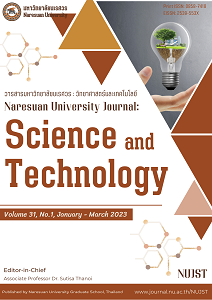Strength Development of Fly Ash-Perlite Based Geopolymer Mortar Using Recycled Waste Glass as Fine Aggregate
DOI:
https://doi.org/10.14456/nujst.2023.1Keywords:
geopolymer, fly ash, perlite, waste glass, compressive strength, fire resistanceAbstract
In this paper, the synthesis of geopolymer mortars using fly ash and perlite with mixing recycled waste glass as a partial fine aggregate replacement was studied. Perlite was used to replace fly ash at weight percentages of 0 to 10, 20, 30, and 40. Waste glass was crushed with the size close to sand. Sand was replaced by waste glass at 20% by weight. Sodium silicate and 10 molar sodium hydroxide solutions were prepared as alkali activator. The workability, strength development, and fire resistance of geopolymer mortars were investigated. The results indicate that the flow and compressive strength of mortars decreased with an increase in perlite content. The strengths of fly ash-perlite geopolymer mortars at 28 days were in the range of 44 to 51 MPa, which is suitable for some engineering applications. The high strength for refractory applications was 95 MPa (70FA30PL), which increased as the sintering temperature increased.
References
Abdullah, M. M. A. B., Jamaludin, L., Hussin, K., Binhussain, M., Ghazali, C. M. R., & Izzat, A. M. (2013). Study on fly ash based geopolymer for coating applications. Advanced Materials Research, 686, 227-233.
Ali, E. E., & Al-Tersawy, S. H. (2012). Recycled glass as a partial replacement for fine aggregate in self-compacting concrete. Construction and Building Materials, 35, 785-791.
American Coal Ash Association. (2003). Fly ash facts for highway engineers. Washington, DC: Federal Highway Administration.
Batayneh, M., Marie, I., & Asi, I. (2007). Use of selected waste materials in concrete mixes. Waste Management, 27, 1870-1876.
Bhowmick, A., & Ghosh, S. (2012). Effect of synthesizing parameters on workability and compressive strength of fly ash based geopolymer mortar. International Journal of Civil and Structural Engineering, 3, 168-177.
Chindaprasirt, P., Chareerat, T., Hatanaka, S., & Cao, T. (2010). High strength geopolymer using fine high calcium fly ash. Journal of Materials in Civil Engineering, 23, 264-270.
Davidovits, J. (1991). Geopolymers-Inorganic polymeric new materials. Journal of Thermal Analysis, 37, 1633-1656.
Duxson, P., Fernandez-Jimenez, A., Provis, J. L., Lukey, G. C., Palomo, A., & van Deventer, J. S. J. (2007). Geopolymer technology: the current state of the art. Journal of Materials Science, 42, 2917-2933.
Duxson, P., Provis, J. L., Lukey, G. C., Mallicoat, S. W., Kriven, W. M., & van Deventer, J. S. J. (2005). Understanding the relationship between geopolymer composition, microstructure and mechanical properties. Colloids and Surfaces A Physicochemical and Engineering Aspects, 269, 47-58.
Erdogan, S.T. (2015). Properties of ground perlite geopolymer mortars. Journal of Materials in Civil Engineering, 27, 1-10.
Haddad, R. H., Ashteyat, A. M., & Lababneh, Z. K. (2018). Producing geopolymer composites using oil shale ash. Structural Concrete, 20, 1-11.
Hager, I. (2013). Colour change in heated concrete. Fire Technology, 1, 1-14.
Matalkah, F., Aqel, R., & Ababneh, A. (2020). Enhancement of the mechanical properties of kaolin geopolymer using sodium hydroxide and calcium oxide. Procedia Manufacturing, 44, 164-171.
Pan, Z., & Sanjayan, J. G. (2012). Factors influencing softening temperature and hot-strength of geopolymers. Cement and Concrete Composites, 34, 261-264.
Pan, Z., Sanjayan, J. G., & Rangan, B. V. (2009). An investigation of the mechanisms for strength gain or loss of geopolymer mortar after exposure to elevated temperature. Journal of Materials Science, 44, 1873-1880.
Photisan, M.S., & Sangphong, O. (2021). A study on properties of fly ash-rice husk ash based geopolymer using recycled waste glass as fine aggregate. International Journal of Science and Innovative Technology, 4, 33-41.
Sinsiri, T., Teeramit, P., Jaturapitakkul, C., & Kiattikomol, K. (2006). Effect of finenesses of fly ash on expansion of mortars in magnesium sulfate. Science Asia, 32, 63-69.
Solouki, A., Viscomi, G., Lamperti, R., & Tataranni, P. (2020). Quarry waste as precursors in geopolymers for civil engineering applications: a decade in review. Materials (Basel), 13, 3146.
Sriwattanapong, M., Sinsiri, T., Pantawee, S., & Chindaprasirt, P. (2013). A study of lightweight concrete admixed with perlite. Suranaree Journal of Science and Technology, 20, 227-234.
Vance, E. R., Perera, D. S., Imperia, P., Cassidy, D. J., Davis, J., & Gourley, J. T. (2009). Perlite waste as a precursor for geopolymer formation. Journal of the Australian Ceramic Society, 45, 44-49.
Vaou, V., & Panias, D. (2010). Thermal Insulating Foamy Geopolymers from Perlite. Minerals Engineering, 23, 1146-1151.
Warnphen, H., Supakata, N., & Kanokkantapong, V. (2019). The reuse of waste glass as aggregate replacement for producing concrete bricks as an alternative for waste glass management on Koh Sichang. Engineering Journal, 23, 43-58.
Downloads
Published
How to Cite
Issue
Section
License
Copyright (c) 2023 Naresuan University Journal: Science and Technology

This work is licensed under a Creative Commons Attribution-NonCommercial 4.0 International License.














